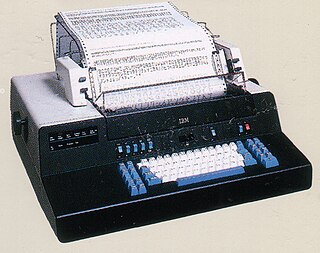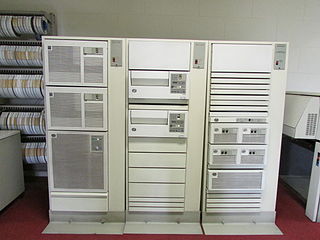IBM mainframes are large computer systems produced by IBM since 1952. During the 1960s and 1970s, IBM dominated the computer market with the 7000 series and the later System/360, followed by the System/370. Current mainframe computers in IBM's line of business computers are developments of the basic design of the System/360.

A mainframe computer, informally called a mainframe or big iron, is a computer used primarily by large organizations for critical applications like bulk data processing for tasks such as censuses, industry and consumer statistics, enterprise resource planning, and large-scale transaction processing. A mainframe computer is large but not as large as a supercomputer and has more processing power than some other classes of computers, such as minicomputers, servers, workstations, and personal computers. Most large-scale computer-system architectures were established in the 1960s, but they continue to evolve. Mainframe computers are often used as servers.

The IBM System/360 (S/360) is a family of mainframe computer systems announced by IBM on April 7, 1964, and delivered between 1965 and 1978. System/360 was the first family of computers designed to cover both commercial and scientific applications and a complete range of applications from small to large. The design distinguished between architecture and implementation, allowing IBM to release a suite of compatible designs at different prices. All but the only partially compatible Model 44 and the most expensive systems use microcode to implement the instruction set, featuring 8-bit byte addressing and fixed-point binary, fixed-point decimal and hexadecimal floating-point calculations. The System/360 family introduced IBM's Solid Logic Technology (SLT), which packed more transistors onto a circuit card, allowing more powerful but smaller computers.

The IBM System/370 (S/370) is a range of IBM mainframe computers announced as the successors to the System/360 family on June 30, 1970. The series mostly maintains backward compatibility with the S/360, allowing an easy migration path for customers; this, plus improved performance, were the dominant themes of the product announcement.
Systems Network Architecture (SNA) is IBM's proprietary networking architecture, created in 1974. It is a complete protocol stack for interconnecting computers and their resources. SNA describes formats and protocols but, in itself, is not a piece of software. The implementation of SNA takes the form of various communications packages, most notably Virtual Telecommunications Access Method (VTAM), the mainframe software package for SNA communications.

CA Technologies, Inc., formerly Computer Associates International, Inc., and CA, Inc., was an American multinational enterprise software developer and publisher that existed from 1976 to 2018. CA grew to rank as one of the largest independent software corporations in the world, and at one point was the second largest. The company created systems software that ran in IBM mainframe, distributed computing, virtual machine, and cloud computing environments.

Amdahl Corporation was an information technology company which specialized in IBM mainframe-compatible computer products, some of which were regarded as supercomputers competing with those from Cray Research. Founded in 1970 by Gene Amdahl, a former IBM computer engineer best known as chief architect of System/360, it has been a wholly owned subsidiary of Fujitsu since 1997. The company was located in Sunnyvale, California.

The IBM 3790 Communications System was one of the first distributed computing platforms. The 3790 was developed by IBM's Data Processing Division (DPD) and announced in 1974. It preceded the IBM 8100, announced in 1979.
Remote job entry, or Remote Batch, is the procedure for sending requests for non-interactive data processing tasks (jobs) to mainframe computers from remote workstations, and by extension the process of receiving the output from such jobs at a remote workstation.

A microform is a scaled-down reproduction of a document, typically either photographic film or paper, made for the purposes of transmission, storage, reading, and printing. Microform images are commonly reduced to about 4% or 1⁄25 of the original document size. For special purposes, greater optical reductions may be used.
Since the rise of the personal computer in the 1980s, IBM and other vendors have created PC-based IBM mainframe-compatible systems which are compatible with the larger IBM mainframe computers. For a period of time PC-based mainframe-compatible systems had a lower price and did not require as much electricity or floor space. However, they sacrificed performance and were not as dependable as mainframe-class hardware. These products have been popular with mainframe developers, in education and training settings, for very small companies with non-critical processing, and in certain disaster relief roles.

A computer operator is a role in IT which oversees the running of computer systems, ensuring that the machines, and computers are running properly. The job of a computer operator as defined by the United States Bureau of Labor Statistics is to "monitor and control ... and respond to ... enter commands ... set controls on computer and peripheral devices. This Excludes Data Entry."
A service bureau is a company that provides business services for a fee. The term has been extensively used to describe technology-based services to financial services companies, particularly banks. Service bureaus are a significant sector within the growing 3D printing industry that allow customers to make a decision whether to buy their own equipment or outsource production. Customers of service bureaus typically do not have the scale or expertise to incorporate these services into their internal operations and prefer to outsource them to a service bureau. Outsourced payroll services constitute a commonly provisioned service from a service bureau.
International Business Machines (IBM) is a multinational corporation specializing in computer technology and information technology consulting. Headquartered in Armonk, New York, the company originated from the amalgamation of various enterprises dedicated to automating routine business transactions, notably pioneering punched card-based data tabulating machines and time clocks. In 1911, these entities were unified under the umbrella of the Computing-Tabulating-Recording Company (CTR).
The history of IBM mainframe operating systems is significant within the history of mainframe operating systems, because of IBM's long-standing position as the world's largest hardware supplier of mainframe computers. IBM mainframes run operating systems supplied by IBM and by third parties.

IBM 3767 Communication Terminal is a serial printer terminal that employed dot matrix print-head technology and, for the first time, the Synchronous Data Link Control (SDLC) communications protocol set under IBM's Systems Network Architecture (SNA). It was introduced in 1974 and was used widely during the late 1970s to 1990s, for attachment to IBM System/360 and System/370 mainframe computers and IBM System/7 as an alternative to a 2741 typewriter terminal.

The IBM 9370 systems are "baby mainframe" midrange computers, released 1986 at the very low end of, and compatible with System/370. The media of the day, referring to the VAX systems manufactured by Digital Equipment Corporation (DEC), carried IBM's alleged "VAX Killer" phrase, albeit often skeptically.

The IBM System/390 is a discontinued mainframe product family implementing ESA/390, the fifth generation of the System/360 instruction set architecture. The first computers to use the ESA/390 were the Enterprise System/9000 (ES/9000) family, which were introduced in 1990. These were followed by the 9672, Multiprise, and Integrated Server families of System/390 in 1994–1999, using CMOS microprocessors. The ESA/390 succeeded ESA/370, used in the Enhanced 3090 and 4381 "E" models, and the System/370 architecture last used in the IBM 9370 low-end mainframe. ESA/390 was succeeded by the 64-bit z/Architecture in 2000.
IBM 2245 Kanji Printer was the line printer of the IBM Kanji System, announced in 1971, that allowed printing of Japanese text on IBM System/360 and System/370 mainframe computers. Later, it would also support printing of Korean and Traditional Chinese text.












